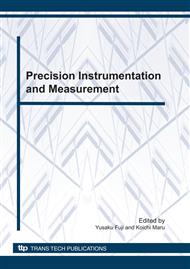[1]
Martini, J. ; Waldman, F. A. ; Suh, N. P. The Production and Analysis of Microcellular Thermoplastic Foams; SPE ANTEC Technical Papers XXVIII; Society of Plastics Engineers: Greenwich, CT, (1982) pp.674-676.
Google Scholar
[2]
Martini, J. E. The Production and Analysis of Microcellular Foam. S. M. Thesis, Massachusettes Institute of Technology, Cambridge, MA, (1981).
Google Scholar
[3]
Doroundani, S. ; Park, C. B.; Kortschot, M. T. Processing and Characterization of Microcellular Foamed High-Density Polyethylene/lsotactic Polypropylene Blends. Polym. Eng. Sci. (1998), P. 1205-1215.
DOI: 10.1002/pen.10289
Google Scholar
[4]
Rachtanapun, P.; Selke, S. E.; Matuana, L. M. Relationship Between Cell Morphology and Impact Strength of Microcellular Foamed High-Density Polyethylene/Polypropylene Blends. Polym. Eng. Sci. (2004), P. 1551-1560.
DOI: 10.1002/pen.20152
Google Scholar
[5]
Rachtanapun, P.; Selke, S. E.; Matuana, L. M. Microcellular Foam of Polymer Blends of HDPE/PP and Their Composites with Wood Fiber. J. Appl. Polym. Sci. 2003, 88, 2842-2850.
DOI: 10.1002/app.12170
Google Scholar
[6]
Lee, Y. H.; Wang, K. H.; Park, C. B.; Sain, M. Effects of Clay Dispersion on the Foam Morphology of LDPE/Clay Nanocomposites. J. Appl. Polym. Sci. (2007), P. 2129-2134.
DOI: 10.1002/app.24908
Google Scholar
[7]
Sun, X. H.; Liu, H. J.; Li, G.; Liao, X.; He, J. S. Investigation on the Cell Nucleation and Cell Growth in Microcellular Foaming by Means of Temperature Quenching. J. Appl. Polym. Sci. (2004), P. 163-171.
DOI: 10.1002/app.20445
Google Scholar
[8]
Wang, J.; Cheng, X.G.; Zheng, X. J.; Yuan, M. J.; He, J. S. Preparation and Characterization of Microcellular Polystyrene/Polystyrene Ionomer Blends with Supercritical Carbon Dioxide. J. Polym. Sci. Part B: Polym Phys. (2003), P. 368-377.
DOI: 10.1002/polb.10371
Google Scholar
[9]
Baldwin, D. F.; Park, C. B.; Suh, N. P. A Microcellular Processing Study of Poly( Ethylene Terephthalate) in the Amorphous and Semicrystalline States. Part I: Microcell Nucleation. Polym. Eng. Sci. (1996), P. 1437-1445.
DOI: 10.1002/pen.10538
Google Scholar
[10]
Matuana, L. M.; Park, C. B.; Balatinecz, J. J. Cell Morphology and Property Relationships of Microcellular Foamed PVC/Wood-Fiber Composites. Polym. Eng. Sci. (1998), P. 1862-1872.
DOI: 10.1002/pen.10356
Google Scholar
[11]
Han, X. M.; Koelling, K. W.; Tomasko, D. L.; Lee, L. J. Continuous Microcellular Polystyrene Foam Extrusion With Supercritical CO2. Polym. Eng. Sci. (2002), P. 2094-2106.
DOI: 10.1002/pen.11100
Google Scholar
[12]
Han, X. M.; Koelling, K. W.; Tomasko, D. L.; Lee, L. J. Effect of Die Temperature on the Morphology of Microcellular Foams. Polym. Eng. Sci. (2003), P. 1206-1220.
DOI: 10.1002/pen.10102
Google Scholar
[13]
Chong, T. H.; Ha, Y. W.; Jeong, D. J. Effect of Dissolved Gas on the Viscosity of HIPS in the Manufacture of Microcellular Plastics. Polym. Eng. Sci. (2003), P. 1337-1344.
DOI: 10.1002/pen.10113
Google Scholar
[14]
Seeler, K. A.; Kumar, V. Tension-tension fatigue of microcellular polycarbonate: Initial results . J. Rein. Plast. Comp. (1993), P. 359-376.
DOI: 10.1177/073168449301200308
Google Scholar
[15]
Kumar, V.; Michael V. W. Experimental characterization of the tensile behavior of microcellular polycarbonate foams. J. Eng. Mater. Technol. (1994), P. 439-445.
Google Scholar
[16]
Huang, Q.; Seibig, B.; Paul, D. Polycarbonate hollow fiber membranes by melt extrusion. J. Membr. Sci. (1999), P. 287-291.
DOI: 10.1016/s0376-7388(99)00122-2
Google Scholar
[17]
Richard, G.; Louis, E. D. Continuous extrusion of microcellular polycarbonate . Polym. Eng. Sci. (2003), P. 1361-1377.
Google Scholar
[18]
Tang, M.; Huang, W. H.; Chen Y.P. Comparisons of the sorption and diffusion of supercritical carbon dioxide into polycarbonate and polysulfone. J. Appl. Polym. Sci. (2004), P. 474-482.
DOI: 10.1002/app.20895
Google Scholar
[19]
John, W. S. L.; Wang, K.Y.; Park, C. B. Challenge to extrusion of low-density microcellular polycarbonate foams using supercritical carbon dioxide. Ind. Eng. Chem. Res. (2005), 44(1), P. 92-99.
DOI: 10.1021/ie0400402
Google Scholar
[20]
Huang, Q.; Klotzer, R.; Seibig, B.; Paul, D. Extrusion of Microcellular Polysulfone Using Chemical Blowing Agents. J. Appl. Polym. Sci. (1998), 69, P. 1753-1760.
DOI: 10.1002/(sici)1097-4628(19980829)69:9<1753::aid-app9>3.0.co;2-a
Google Scholar
[21]
Kaewmesri, W.; Rachtanapun, P.; Pumchusak, J. Effect of Solvent Plasticization on Polypropylene Microcellular Foaming Process and Foam Characteristics. J. Appl. Polym. Sci. (2008), 107, P. 63-70.
DOI: 10.1002/app.27103
Google Scholar


